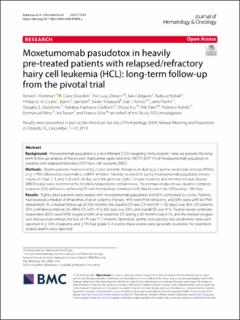Moxetumomab pasudotox in heavily pre-treated patients with relapsed/refractory hairy cell leukemia (HCL): long-term follow-up from the pivotal trial
Kreitman, Robert J.; Dearden, Claire; Zinzani, Pier Luigi; Delgado, Julio; Robak, Tadeusz; le Coutre, Philipp; Gjertsen, Bjørn Tore; Troussard, Xavier; Roboz, Gail J.; Karlin, Lionel; Gladstone, Douglas E.; Kuptsova-Clarkson, Nataliya; Liu, Shiyao; Patel, Priti; Rotolo, Federico; Mitry, Emmanuel; Pastan, Ira; Giles, Frank
Journal article, Peer reviewed
Published version

Åpne
Permanent lenke
https://hdl.handle.net/11250/2991870Utgivelsesdato
2021Metadata
Vis full innførselSamlinger
- Department of Clinical Science [2291]
- Registrations from Cristin [9482]
Sammendrag
Background
Moxetumomab pasudotox is a recombinant CD22-targeting immunotoxin. Here, we present the long-term follow-up analysis of the pivotal, multicenter, open-label trial (NCT01829711) of moxetumomab pasudotox in patients with relapsed/refractory (R/R) hairy cell leukemia (HCL).
Methods
Eligible patients had received ≥ 2 prior systemic therapies, including ≥ 2 purine nucleoside analogs (PNAs), or ≥ 1 PNA followed by rituximab or a BRAF inhibitor. Patients received 40 µg/kg moxetumomab pasudotox intravenously on Days 1, 3, and 5 of each 28-day cycle for up to six cycles. Disease response and minimal residual disease (MRD) status were determined by blinded independent central review. The primary endpoint was durable complete response (CR), defined as achieving CR with hematologic remission (HR, blood counts for CR) lasting > 180 days.
Results
Eighty adult patients were treated with moxetumomab pasudotox and 63% completed six cycles. Patients had received a median of three lines of prior systemic therapy; 49% were PNA-refractory, and 38% were unfit for PNA retreatment. At a median follow-up of 24.6 months, the durable CR rate (CR with HR > 180 days) was 36% (29 patients; 95% confidence interval: 26–48%); CR with HR ≥ 360 days was 33%, and overall CR was 41%. Twenty-seven complete responders (82%) were MRD-negative (34% of all patients). CR lasting ≥ 60 months was 61%, and the median progression-free survival without the loss of HR was 71.7 months. Hemolytic uremic and capillary leak syndromes were each reported in ≤ 10% of patients, and ≤ 5% had grade 3–4 events; these events were generally reversible. No treatment-related deaths were reported.
Conclusions
Moxetumomab pasudotox resulted in a high rate of durable responses and MRD negativity in heavily pre-treated patients with HCL, with a manageable safety profile. Thus, it represents a new and viable treatment option for patients with R/R HCL, who currently lack adequate therapy.
